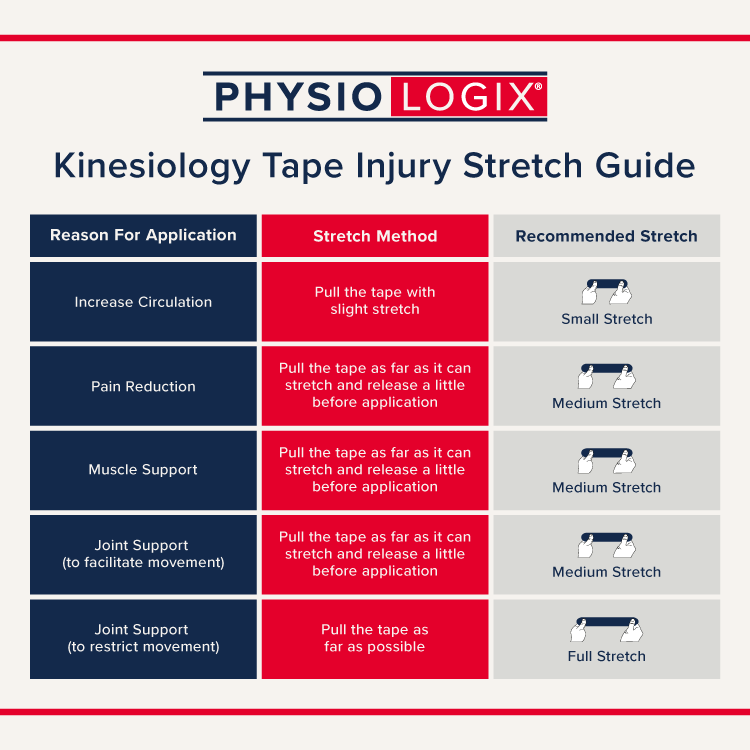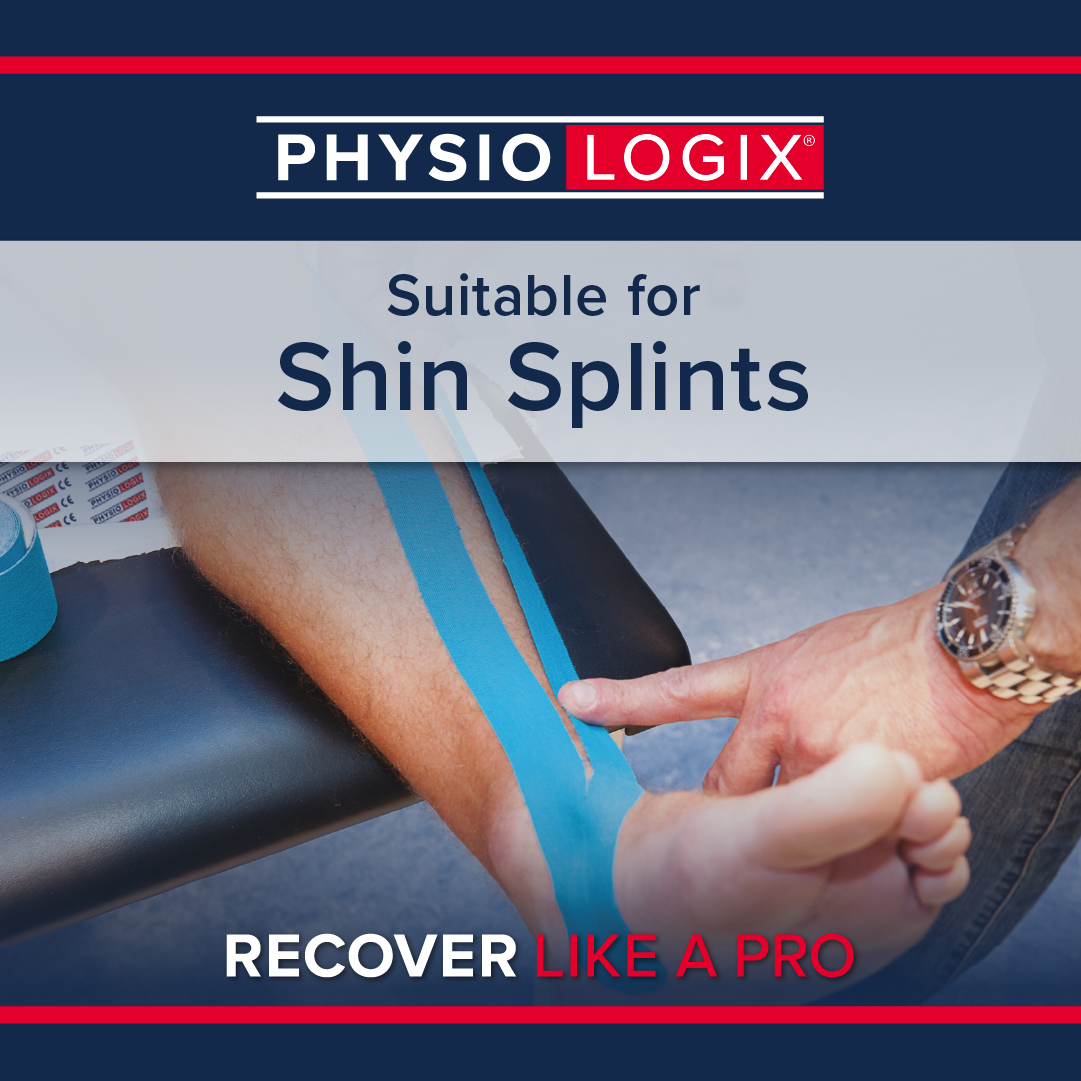Headlines
Recover Like a Pro: What is Kinesiology Tape? When Should I use it & Why?
30 May 2022
 Reduced swelling and inflammation, improved blood flow and circulation,
and injury prevention are just some of the many benefits of kinesiology tape when it is used correctly.
Reduced swelling and inflammation, improved blood flow and circulation,
and injury prevention are just some of the many benefits of kinesiology tape when it is used correctly.
It wraps the muscles and surrounding tissues with support, promoting relief and maintains balance in the muscles and tissues.
The Physiologix Kinesiology Tape range mimics human skin in thickness and elasticity facilitating strength to the area it's applied to. The tape is a combination of elastic, cotton, and latex-free fibres which create adhesive properties. these materials make the tape string, breathable and water-resistant allowing long-lasting, comfortable use. When applied correctly, the tape can stay in place for up to four days.

When preparing the tape, think of these 3 keywords; Measure, Cut, Round.

Measure: Measure the piece of tape in accordance with the area you wish to cover leaving plenty of room for stretch. Follow the guide below to determine how much tape is needed and how much stretch is required.
Cut: Ensure you have a sharp pair of scissors to cut the tape as blunt scissors will fray your trip causing it to peel off the skin. The Medicare Sharp Dressing Scissors are made if high-quality stainless steel featuring a sharp cutting edge for precise cuts. The size of the tape will depend on both the desired target area and the purpose of the application. If you wish to apply tension to the area for pain relief, the kinesiology tape cut should be shorter than the length of where it's being applied to leave room for stretch.
Round: Once the tape size is chosen and cut, ensure to round the edges of both sides of the tape. this will help minimise lifting and improve overall adhesion.

Anchor: Anchor the tape into position and stick down the first two inches using no stretch. It is vital that you do not stretch the first and last two inches at either end of the tape as it can cause discomfort and skin irritation, which results in the tape lifting easily.
Stretch: Stretch the middle of the tape to the desired level depending on your injury. Refer to the table below for our stretch reference guide:
Stick: In order to get your tape to stick perfectly, there are a few rules to follow. Avoid touching the sticky adhesive when applying. Once it meets the skin, it immediately loses some of its adhesion. Preparing the skin will allow the tape to adhere to the skin in the best way possible. After application, rub the tape to secure the adhesive. Friction will help to bond the tape more to your skin.
Unsure of what level of stretch you need to achieve the correct support and effectiveness? Refer to the guide below:

Resources:
The Physiologix Kinesiology Tape range mimics human skin in thickness and elasticity facilitating strength to the area it's applied to. The tape is a combination of elastic, cotton, and latex-free fibres which create adhesive properties. these materials make the tape string, breathable and water-resistant allowing long-lasting, comfortable use. When applied correctly, the tape can stay in place for up to four days.
Benefits of Physiologix Kinesiology Tape:
- Relieves pain in overworked muscles and joints
- Reduces swelling and inflammation
- Accelerates muscle recovery
- Improves overall athletic performance
- Reduces risk of injury
- Optimises comfort and muscle support
How to correctly apply Physiologix Kinesiology Tape:
The following video gives a step-by-step visual representation of how to correctly apply kinesiology tape by Darragh, a member of our team.
Preparation is Key
Prepare the Skin: It is important to clean and dry the skin before application. Make sure the skin is free of oils or moisturising creams as it can affect the adhesiveness of the tape. Shave the area, if possible, for the best application results.When preparing the tape, think of these 3 keywords; Measure, Cut, Round.

Measure: Measure the piece of tape in accordance with the area you wish to cover leaving plenty of room for stretch. Follow the guide below to determine how much tape is needed and how much stretch is required.
Cut: Ensure you have a sharp pair of scissors to cut the tape as blunt scissors will fray your trip causing it to peel off the skin. The Medicare Sharp Dressing Scissors are made if high-quality stainless steel featuring a sharp cutting edge for precise cuts. The size of the tape will depend on both the desired target area and the purpose of the application. If you wish to apply tension to the area for pain relief, the kinesiology tape cut should be shorter than the length of where it's being applied to leave room for stretch.
Round: Once the tape size is chosen and cut, ensure to round the edges of both sides of the tape. this will help minimise lifting and improve overall adhesion.
Tips for Application:
For application, follow 3 simple steps; Anchor, Stretch, Stick.
Anchor: Anchor the tape into position and stick down the first two inches using no stretch. It is vital that you do not stretch the first and last two inches at either end of the tape as it can cause discomfort and skin irritation, which results in the tape lifting easily.
Stretch: Stretch the middle of the tape to the desired level depending on your injury. Refer to the table below for our stretch reference guide:
Stick: In order to get your tape to stick perfectly, there are a few rules to follow. Avoid touching the sticky adhesive when applying. Once it meets the skin, it immediately loses some of its adhesion. Preparing the skin will allow the tape to adhere to the skin in the best way possible. After application, rub the tape to secure the adhesive. Friction will help to bond the tape more to your skin.
Unsure of what level of stretch you need to achieve the correct support and effectiveness? Refer to the guide below:

After Care:
- Physiologix Kinesiology tape is waterproof, just remember to pat dry after showering/water activities.
- If you begin to feel discomfort caused by the tape at any stage, remove it immediately.
When not to apply Kinesiology Tape:
- Refrain from applying the tape if you are someone who suffers from skin allergies.
- Never apply to open wounds or to any skin that is unhealed or broken.
- DVT (Deep Vein Thrombosis) is a condition where blood clots in one or more deep veins in the body and using kinesiology tapes can cause these clots to break free. This can result in the clots travelling to another part of the body.
- Taping should never be done when clotting is present in the area.
- If you have cancer, taping is not advised as it may cause cells to spread to other parts of the body.
Follow Physiologix on social media for updates
Resources:





